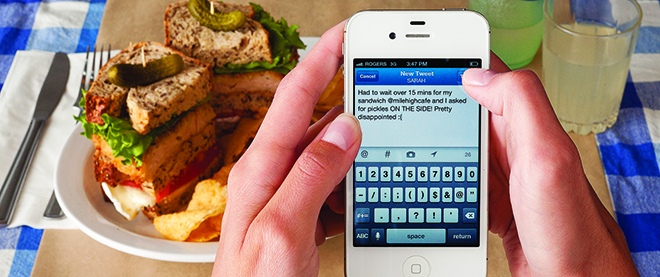@chef: the soup needs salt. Hello?
Restaurants have a new nemesis: real-time food criticism in 140 characters or less
Blogging or bullying? Criticizing a restaurant via Twitter in hopes of getting something comped is ‘so hugely unethical,’ says one food reviewer
Share

First came the bloggers, then the Chowhounders and Yelpers. Today, restaurants must contend with a new breed of critic: the tweeters.
On a recent Monday afternoon, Amy Lu, a Toronto-based food blogger, tweeted to her 650-plus followers that she was excited to have high tea at the Windsor Arms, a luxury hotel in her city. Her enthusiasm was confirmed by a smiley-face emoticon. Twenty minutes later, Lu’s mood had shifted: “Wow @windsorarms,” she wrote, “I’m not impressed with the service so far . . . It better be good or bad review from me.” Precisely two minutes later, the Windsor Arms, which has nearly 11,000 followers, replied: “Are you here for afternoon tea now?” Lu confirmed she was. Fifteen minutes later, the blogger tweeted to the hotel, “Thanks so much for finding me and helping me improve my experience here.”
It was a social media success story—or did a hobbyist reviewer just bully a restaurant in a very public way? Food writer Ivy Knight, the publisher of Swallow.com, who tweeted during the exchange that she was sorry to see the Windsor Arms get a Twitter shakedown from a blogger with less than 1,000 followers, thought the latter. Knight ended with, “Please tell me you didn’t comp anything.” In fact, Lu, who hadn’t been seated yet when her tweets were sent, was given a spa voucher. Lu says she has never sent a negative tweet before. “But that day, there was just one thing after another,” explains the 26-year-old. “No one greeted me or asked if I needed some help.” She also felt her server was condescending when she presented a Daily Deals voucher. “Restaurants should be able to take the criticism,” says Lu, who works as a baker and social media handler at Le Dolci, a business that offers dessert-decorating classes.
And the Windsor Arms did. Still, “we have set seating times,” explains Christine Korda, the hotel’s director of communications. “She got here early and her table wasn’t ready. She also thought someone was seated before [her].” Laura Serra, Account Supervisor at Narrative PR who’s worked with restaurants, says some are scared of social media. “All of a sudden you have people talking about your brand [in ways] that you can’t control. We’re all flying by the seat of our pants. It’s a new form of customer service.”
Not all restaurants react with the same patience. U.S. Food reporter Steve Dolinsky was kicked out of Charlie Trotter’s restaurant in Chicago last September for negatively tweeting throughout his meal. He was also booted from chef Graham Elliot’s place, G.E.B., this June before even launching a tweet. As Elliot explained to Eater.com, Dolinsky’s behaviour at Trotter’s was “so egregiously over the line that I absolutely will not have someone like that at my establishment.” Chris Nuttall-Smith, the food reviewer for the Globe and Mail, says some bloggers tweet their grievances in the hopes of getting something free in return: “It’s so hugely unethical and it rubs off on the whole blogging community.”
Knight, who worked as a chef for 10 years, witnessed this first-hand at a Toronto restaurant when a blogger—“the worst writer, practically illiterate”—somehow managed to get the meal comped by complaining on Twitter about everything from the service to the food, and then left without leaving a tip. “And that guy ends up feeling all this power and gets a giant ego, until he gets put in his place.”
Knight believes a more decorous solution is simple: “Talk to the other humans in the space instead of pulling out a machine and ignoring them.” But Serra believes mustering up the courage is not easy. “I think unfortunately that’s what Twitter is for a lot of people now.”
Ironically, traditional food writing emerged in the 19th century in tandem with etiquette manuals, which detailed fine points such as how to behave when you’re invited to dinner. “You had this new social place where people had to be taught how to behave,” says Heather Evans, a professor at Queen’s whose research interests include culinary and etiquette history. The word “gastronomy” itself, Evans points out, means stomach and law. “It does suggest a kind of orderliness, which we’ve lost. Now, we’re in this lawless food territory,” she says. “And maybe it’s a little too chaotic.”